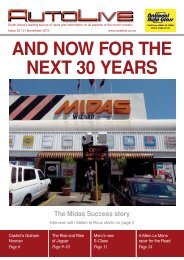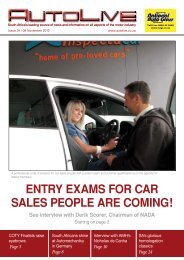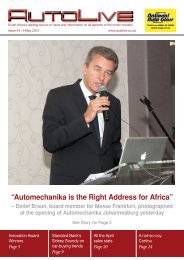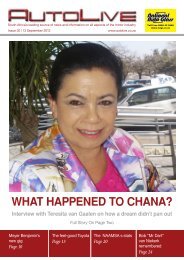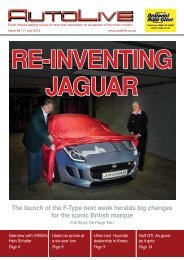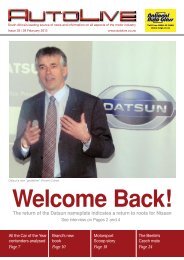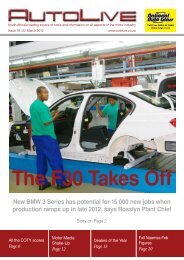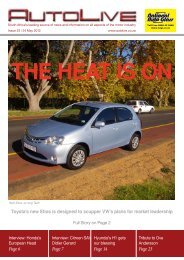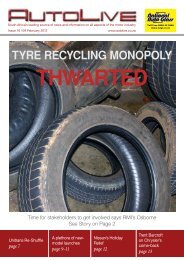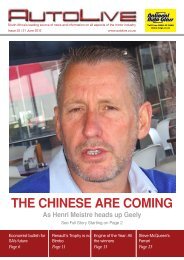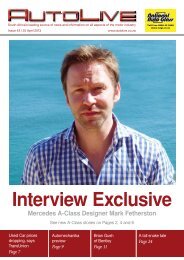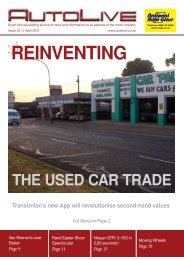TRAINING IS THE KEY - Autolive.co.za
TRAINING IS THE KEY - Autolive.co.za
TRAINING IS THE KEY - Autolive.co.za
Create successful ePaper yourself
Turn your PDF publications into a flip-book with our unique Google optimized e-Paper software.
Subscribe for free @<br />
www.autolive.<strong>co</strong>.<strong>za</strong> Page 11<br />
Amarok Gets More Low-Down Grunt<br />
By Stuart Johnston<br />
Interestingly enough, Volkswagen doesn’t claim an<br />
increase in torque for its new and improved 132 kW<br />
version of the Amarok bakkie, launched last week to<br />
the media at a game farm near Britz.<br />
The data received from VWSA says that the<br />
power increase has been achieved without affecting<br />
the spread of torque on the previous, 120 kW version<br />
of the engine, and this remains at a healthy 400<br />
Nm delivered between 1 500 and 2 250 rpm.<br />
And yet, the biggest improvement to the<br />
Amarok has been the curing of the low-speed stalling<br />
problem, most notable when pulling away on<br />
an incline at Reef altitudes. It needed careful balancing<br />
of the clutch and throttle, something that<br />
we pointed out in our test of the vehicle just over<br />
a year ago.<br />
Apparently, a redesigned clutch has also been<br />
fitted to the vehicle, and this can in fact be retrofitted<br />
to existing 120 kW examples using the 2,0<br />
BiTDI four-cylinder diesel engine, which makes the<br />
action much less abrupt.<br />
On the launch route we fiddled about at low<br />
speeds, testing the torque and using an engine<br />
speed lower than really suitable for the <strong>co</strong>nditions<br />
trying to invoke the previous bug-bare, and on this<br />
short sampling it seems as if it is Problem Solved.<br />
That’s good news, because in all respects, other<br />
than the fact that the small-capacity diesel is likely<br />
to have to work harder for its living than a lazier,<br />
big-capacity unit, the Amarok is the most <strong>co</strong>mplete<br />
bakkie you can buy. I would still probably opt for a<br />
Hilux, because it such a proven device, but I’m the<br />
type of person that intends keeping a vehicle for<br />
decades rather than years. If I were to choose a bakkie<br />
to live with for just two to three years, this would<br />
be the one. And once the reliability is proven, the<br />
Amarok is a no-brainer.<br />
The main reason is the ride. No other bakkie<br />
<strong>co</strong>mes close to the Amarok in terms of ride on<br />
both tar and dirt. It is more precise in its on-road<br />
behaviour than anything out there, and on poor<br />
quality gravel it soaks up bumps and ripples that<br />
would have other vehicles dancing around like<br />
Elvis soon after he dis<strong>co</strong>vered amphetamines. Its<br />
ability to cushion the driver from bumps small<br />
and large and still retain such <strong>co</strong>ntrolled precision<br />
is an object lesson to anyone else in the<br />
bakkie-building arena.<br />
This car-like <strong>co</strong>mposure extends to the cabin<br />
too. It has Volkswagen DNA strongly in its dashboard<br />
design, with none of the garishness that other<br />
bakkie-builders seem to think is necessary to denote<br />
a class act.<br />
We drove the 4X2 models on the launch, although<br />
the new 132 kW version is obviously available<br />
in 4Motion four-wheel-drive form too, with<br />
low range for serious off-road work. The 4X2 BiTDI<br />
sells for R375 100, with the 4Motion selling for<br />
R425 300.<br />
Other models in the double cab range are the<br />
2,0-litre TSi petrol 4X2, priced at R313 500 and twowheel<br />
drive and four-wheel-drive 90 kW TDi diesel<br />
models at R341 700 and R391 900<br />
Backing up its designed-in impeccable road<br />
manners is the full ESP driver-aid system which<br />
works exceptionally well in checking skids on dirt<br />
roads and on slippery tar, or in emergency manoeuvres.<br />
Amarok was first in the double-cab market to<br />
introduce electronic traction aids, although others<br />
have now followed suit.<br />
VW reckons that fuel e<strong>co</strong>nomy has been a major<br />
selling point for these vehicles and owners can<br />
expect e<strong>co</strong>nomy under 9 litres per 100 with the<br />
BiTDI 4X2 model. The officially claim is under eight<br />
litres/100 for this model.<br />
VW has had a reasonably successful launch<br />
of the Amarok, occupying se<strong>co</strong>nd position in the<br />
Double Cab market for some months since its<br />
launch in September 2010. Since that time some<br />
7 200 Double Can Amaroks have been sold, and<br />
VWSA says it hopes to regain the number two position<br />
now that supply problems from Argentina,<br />
where the Amarok is built, have been sorted out.<br />
At present, the top two Double Can pick-ups in<br />
the sales stakes are Toyota’s Hilux and Ford’s new<br />
Ranger, which both employ much larger-capacity<br />
diesel engines in their top models<br />
*For an interview with Ja<strong>co</strong> Steenekamp on<br />
VW’s successes and challenges in the SA Double<br />
Cab market, see page 10. ■<br />
On tar and gravel, the Amarok takes some beating. The new 132 kW engine has more low-down, low-rev ability.<br />
To advertise in<br />
<strong>co</strong>ntact<br />
Bruno Lupini on 081 354 7212 or email him at bruno.lupini@gmail.<strong>co</strong>m



